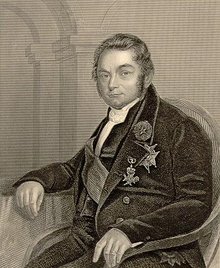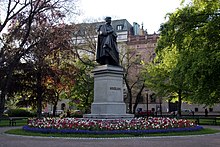Jöns Jacob Berzelius: Difference between revisions
No edit summary |
|||
| Line 18: | Line 18: | ||
==Further Reading== |
==Further Reading== |
||
A biography on ''Jac. Berzelius and his fish - his life and work'' was written by J. Erik Jorpes and published in 1966 and 1970 (originally in Swedish, first published in 1949). |
A biography on ''Jac. Berzelius and his fish - his life and work'' was written by J. Erik Jorpes and published in 1966 and 1970 (originally in Swedish, first published in 1949). |
||
{{cite journal |
|||
| title = Jöns Jacob Berzelius A Guide to the Perplexed Chemist |
|||
| author = Jaime Wisniak |
|||
| journal = The Chemical Educator |
|||
| year = 2000 |
|||
| volume = 5 |
|||
| issue = 6 |
|||
| pages = 343-350 |
|||
| doi = 10.1007/s00897000430a |
|||
}} |
|||
==External links== |
==External links== |
||
Revision as of 20:06, 9 January 2007


Jöns Jakob Berzelius (August 20, 1779 – August 7, 1848) was a Swedish chemist. He invented the modern chemical notation, and is together with John Dalton and Antoine Lavoisier considered a father of modern chemistry.
Berzelius was born in Linköping in Östergötland in Sweden, where he attended the school today known as Katedralskolan. Thereafter he enrolled at the Uppsala University where he learnt the profession of medical doctor. In 1802 he became a teacher, and was in 1807 appointed professor in medicine and surgery at the Stockholm School of Surgery. In 1810 the school became a part of Medico-Chirurgiska institutet, the predecessor to the Karolinska Institute, and Berzelius was appointed professor in chemistry and pharmacy.
Not long after arriving to Stockholm he wrote a chemistry textbook for his medical students, from which point a long and fruitful career in chemistry began. While conducting experiments in support of the textbook he discovered the law of constant proportions, which showed that inorganic substances are composed of different elements in constant proportions by weight. Based on this, in 1828 he compiled a table of relative atomic weights, where oxygen was set to 100, and which included all of the elements known at the time. This work provided evidence in favour of the atomic hypothesis: that inorganic chemical compounds are composed of atoms combined in whole number amounts. In discovering that atomic weights are not integer multiples of hydrogen's, Berzelius also disproved Prout's hypothesis that elements are built up from atoms of hydrogen.
In order to aid his experiments, he developed a system of chemical notation in which the elements were given simple written labels—such as O for oxygen, or Fe for iron—with proportions noted by numbers. This is the same basic system used today, the only difference being that instead of the subscript number used today (e.g., H2O), Berzelius used a superscript.
Berzelius is credited with identifying the chemical elements silicon, selenium, thorium, and cerium. Students working in Berzelius laboratory also discovered lithium, and vanadium.
Berzelius had an impact on biology as well. He was the first person to make the distinction between organic compounds (those containing carbon), and inorganic compounds. In particular, he advised Gerhardus Johannes Mulder in his elemental analyses of organic compounds such as coffee, tea and various proteins. The term "protein" itself was coined by Berzelius, after Mulder observed that all proteins seemed to have the same empirical formula and might be composed of a single type of (very large) molecule.
Berzelius was a prolific correspondent, advising many leading scientists (such as Mulder, Claude Louis Berthollet, Humphry Davy, Friedrich Wöhler and Eilhard Mitscherlich), and fostering many less-notable scientists.
Berzeliusskolan, a school situated next to his alma mater Katedralskolan, is named for him.
Further Reading
A biography on Jac. Berzelius and his fish - his life and work was written by J. Erik Jorpes and published in 1966 and 1970 (originally in Swedish, first published in 1949). Jaime Wisniak (2000). "Jöns Jacob Berzelius A Guide to the Perplexed Chemist". The Chemical Educator. 5 (6): 343–350. doi:10.1007/s00897000430a.
